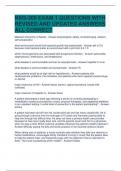NSG-300 EXAM 1 QUESTIONS WITH
REVISED AND UPDATED ANSWERS
ALL CORRECT
Maslow's Hierarchy of Needs - Answer-physiological, safety, love/belonging, esteem,
self-actualization
what environment would limit bacterial growth (be bactericidal) - Answer-pH of 3.0
because most bacteria prefer an environment with a pH from 5.0-7.0
which microorganisms are associated with exogenous infection - Answer-salmonella,
staphylococci, enterococci, and streptococci
what disease is communicable and can be asymptomatic - Answer-hepatitis C virus
what disease is communicable and symptomatic - Answer-Tb
what patients would be at high risk for hypothermia - Answer-patients with
cardiovascular problems, the homeless, and patients who have ingested excess drugs
or alcohol
major reservoirs of HIV - Answer-blood, semen, vaginal secretions, breast milk
(vehicles)
major reservoir of hepatitis A - Answer-feces
A patient discharged a week ago following a stroke is currently participating in
rehabilitation sessions provided by nurses, physical therapists, and registered dietitians
in an outpatient setting. In what level of prevention is the patient participating? - Answer-
tertiary
A patient has been laid off from his construction job and has many unpaid bills. He is
going through a divorce from his marriage of 15 years and has been praying daily to
help him through this difficult time. He does not have a primary health care provider
because he has never really been sick, and his parents never took him to a physician
when he was a child. Which external variables influence the patient's health practices? -
Answer-difficulty paying his bills and family practice of not routinely seeing a doctor
When taking care of patients, a nurse routinely asks whether they take any vitamins or
herbal medications, encourages family members to bring in music that the patient likes
to help the patient relax, and frequently prays with her patients if that is important to
them. The nurse is practicing which model? - Answer-holistic
, normal adult capnography - Answer-35-45mmHg
chills are caused by - Answer-vasoconstriction, piloerection, epinephrine secretion,
shivering
patterns of fever - Answer-sustained, intermittent, remittent, relapsing
Korotkoff phases - Answer-Phase 1- A sharp thump
Phase 2- A blowing or whooshing sound
Phase 3- A crisp, intense tapping
Phase 4- A softer blowing sound that fades
Phase 5- Silence
host characteristics influencing susceptibility to disease - Answer-age, sex, ethnicity,
socioeconomic status, marital status, lifestyle, heredity, nutritional status, occupation,
immunization status, therapeutic procedures, meds, pregnancy, trauma
Lab tests to screen for infection - Answer-WBC count, cultures of urine and blood, iron
level
Airborne precautions - Answer-precautions: private room, negative pressure airflow,
mask or respirator
airborne diseases - Answer-measles, varicella, tuberculosis, disseminated herpes
zoster, rubeola
Droplet precautions - Answer-Private room, mask
Droplet diseases - Answer-influenza, rhinovirus, pneumoniae, diphtheria, rubella,
mumps
contact precautions - Answer-private room, clean gloves, gown,
contact diseases - Answer-MRSA, C.diff, scabies, herpes simplex
Protective environment - Answer-Private room; positive airflow; mask to be worn by
patient when out of room during times of construction in area (kidney transplant)
A patient who has been placed on Contact Precautions for Clostridium difficile (C.
difficile) asks you to explain what he should 464know about this organism. What is the
most appropriate information to include in patient teaching? - Answer--The organism is
usually transmitted through the fecal-oral route.
-Hands should always be cleaned with soap and water versus alcohol-based hand
sanitizer.
-Everyone coming into the room must be wearing a gown and gloves.




